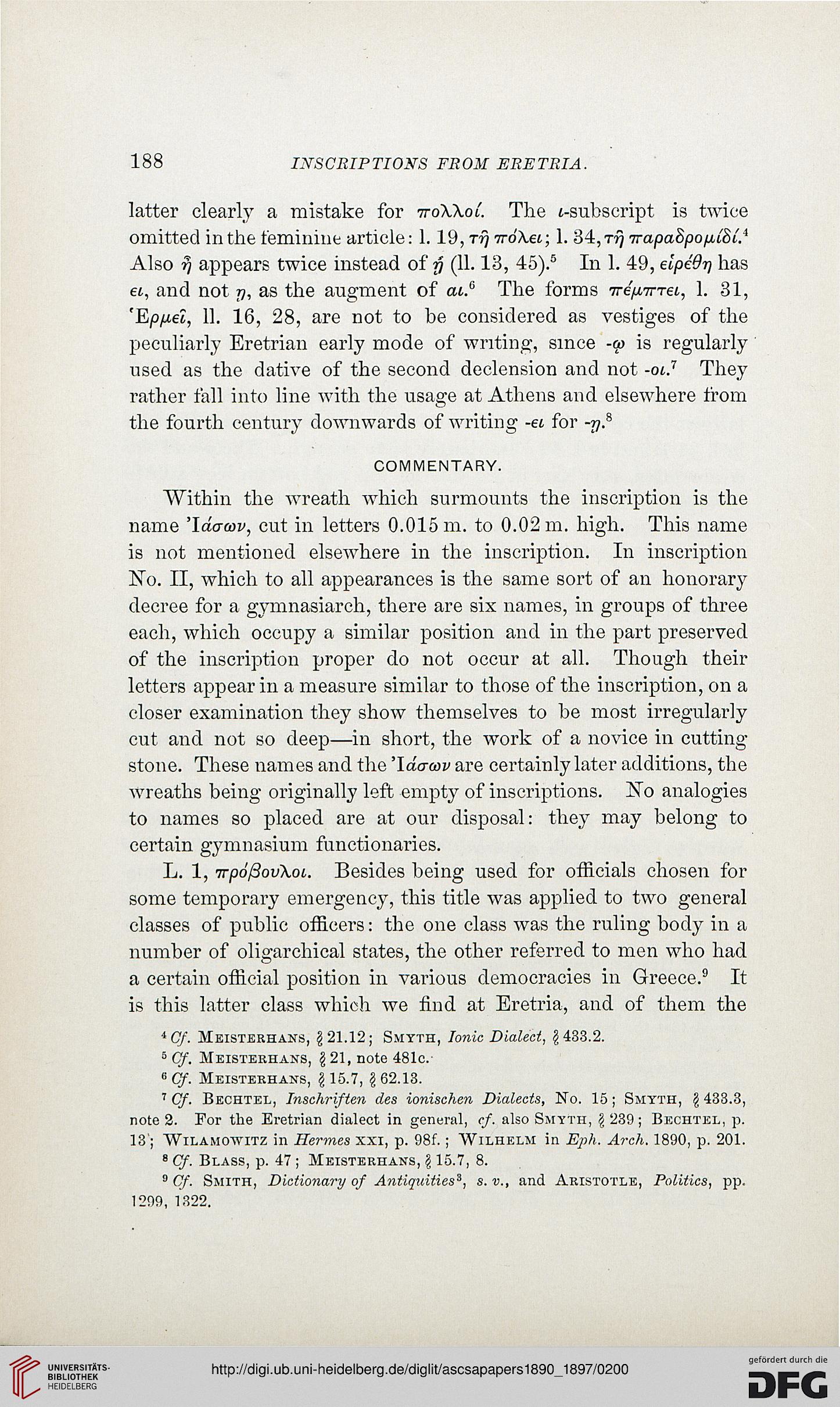188
INSCRIPTION'S FROM ERE TBI A.
latter clearly a mistake for iroWoC. The (-subscript is twice
omitted in the feminine article: 1. 19, rr\ TroXei; 1. 34, ri) irapahpofxlhl^
Also r) appears twice instead of y (11.13, 45).5 In 1. 49, elpe9r) has
et, and not y, as the augment of ai.a The forms Tre/ATrrei, 1. 31,
'Ep/xei, 11. 16, 28, are not to be considered as vestiges of the
peculiarly Eretrian early mode of writing, since -a> is regularly
used as the dative of the second declension and not -oiJ They
rather fall into line with the usage at Athens and elsewhere from
the fourth century downwards of writing -et for -rj.s
COMMENTARY.
"Within the wreath which surmounts the inscription is the
name 'Idacov, cut in letters 0.015 m. to 0.02 m. high. This name
is not mentioned elsewhere in the inscription. In inscription
No. II, which to all appearances is the same sort of an honorary
decree for a gymnasiarch, there are six names, in groups of three
each, which occupy a similar position and in the part preserved
of the inscription proper do not occur at all. Though their
letters appear in a measure similar to those of the inscription, on a
closer examination they show themselves to be most irregularly
cut and not so deep—in short, the work of a novice in cutting
stone. These names and the 'Idacov are certainly later additions, the
wreaths being originally left empty of inscriptions. No analogies
to names so placed are at our disposal: they may belong to
certain gymnasium functionaries.
L. 1, 7rp6/3ov\oL. Besides being used for officials chosen for
some temporary emergency, this title was applied to two general
classes of public officers: the one class was the ruling body in a
number of oligarchical states, the other referred to men who had
a certain official position in various democracies in Greece.9 It
is this latter class which we find at Eretria, and of them the
iC/. Meisterhans, §21.12; Smyth, Tonic Dialect, §433.2.
6 Cf. Meisterhans, I 21, note 481c.
"Of. Meisterhans, § 15.7, §62.13.
7 Cf. Beohtel, Inschriften des ionischen Dialects, No. 15; Smyth, §433.3,
note 2. For the Eretrian dialect in general, cf. also Smyth, § 239; Beohtel, p.
13'; Wilamowitz in Hermes xxi, p. 98f. ; Wilhelm in Eph. Arch. 1890, p. 201.
8 Cf. Blass, p. 47 ; Meisterhans, \ 15.7, 8.
9 Cf. Smith, Dictionary of Antiquities3, s.v., and Aristotle, Politics, pp.
1299, 1322.
INSCRIPTION'S FROM ERE TBI A.
latter clearly a mistake for iroWoC. The (-subscript is twice
omitted in the feminine article: 1. 19, rr\ TroXei; 1. 34, ri) irapahpofxlhl^
Also r) appears twice instead of y (11.13, 45).5 In 1. 49, elpe9r) has
et, and not y, as the augment of ai.a The forms Tre/ATrrei, 1. 31,
'Ep/xei, 11. 16, 28, are not to be considered as vestiges of the
peculiarly Eretrian early mode of writing, since -a> is regularly
used as the dative of the second declension and not -oiJ They
rather fall into line with the usage at Athens and elsewhere from
the fourth century downwards of writing -et for -rj.s
COMMENTARY.
"Within the wreath which surmounts the inscription is the
name 'Idacov, cut in letters 0.015 m. to 0.02 m. high. This name
is not mentioned elsewhere in the inscription. In inscription
No. II, which to all appearances is the same sort of an honorary
decree for a gymnasiarch, there are six names, in groups of three
each, which occupy a similar position and in the part preserved
of the inscription proper do not occur at all. Though their
letters appear in a measure similar to those of the inscription, on a
closer examination they show themselves to be most irregularly
cut and not so deep—in short, the work of a novice in cutting
stone. These names and the 'Idacov are certainly later additions, the
wreaths being originally left empty of inscriptions. No analogies
to names so placed are at our disposal: they may belong to
certain gymnasium functionaries.
L. 1, 7rp6/3ov\oL. Besides being used for officials chosen for
some temporary emergency, this title was applied to two general
classes of public officers: the one class was the ruling body in a
number of oligarchical states, the other referred to men who had
a certain official position in various democracies in Greece.9 It
is this latter class which we find at Eretria, and of them the
iC/. Meisterhans, §21.12; Smyth, Tonic Dialect, §433.2.
6 Cf. Meisterhans, I 21, note 481c.
"Of. Meisterhans, § 15.7, §62.13.
7 Cf. Beohtel, Inschriften des ionischen Dialects, No. 15; Smyth, §433.3,
note 2. For the Eretrian dialect in general, cf. also Smyth, § 239; Beohtel, p.
13'; Wilamowitz in Hermes xxi, p. 98f. ; Wilhelm in Eph. Arch. 1890, p. 201.
8 Cf. Blass, p. 47 ; Meisterhans, \ 15.7, 8.
9 Cf. Smith, Dictionary of Antiquities3, s.v., and Aristotle, Politics, pp.
1299, 1322.





